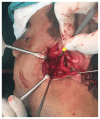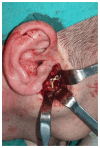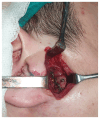Open surgical approach to fractures of the mandibular condyle: surgical technique and associated complications
- PMID: 39473755
- PMCID: PMC11518349
- DOI: 10.55730/1300-0144.5887
Open surgical approach to fractures of the mandibular condyle: surgical technique and associated complications
Abstract
Background/aim: This study evaluates anatomical reduction and rigid internal fixation of mandibular condyle fractures using the preauricular retroparotid approach. It also discusses advantages, deficiencies, and associated complications of the technique.
Materials and methods: This retrospective study reviewed the medical records of a total of 52 mandibular condyle fractures from 42 patients who were treated with open surgery using the preauricular retroparotid approach between January 2019 and January 2024. Preoperative and postoperative assessments included measurements of mouth opening (maximum interincisal distance), vertical mandibular movement, and facial paralysis. Moreover, the Vancouver Scar Scale (VSS) was used to evaluate scar quality at the surgical site. Descriptive statistics were used to summarize patient demographics, preoperative findings, and postoperative outcomes.
Results: Anterior open bite was the most common finding, detected in 83% of the patients before surgery. The mean mouth opening of the patients increased significantly from 29 ± 4.94 mm to 37.76 ± 2.12 mm. Vertical mandibular movement exceeding 4 cm was a finding in more than half (52.3%) of the patients. The mean VSS score, indicating scar quality, was 1.64 ± 0.70, suggesting overall good cosmetic outcomes. Plate breakage in two patients was noted as a complication during follow-up.
Conclusion: Several surgical techniques have been described for mandibular condyle fractures, each with its own benefits and limitations.
Keywords: Maxillofacial surgery; complications; internal fracture fixation; mandibular condyle; mandibular fractures.
© TÜBİTAK.
Figures







Similar articles
-
Open reduction and internal fixation of extracapsular mandibular condyle fractures: a long-term clinical and radiological follow-up of 25 patients.BMC Surg. 2014 Sep 7;14:68. doi: 10.1186/1471-2482-14-68. BMC Surg. 2014. PMID: 25196114 Free PMC article.
-
Modified endaural approach for the treatment of condylar fractures: A review of 75 cases.Indian J Dent Res. 2016 May-Jun;27(3):305-11. doi: 10.4103/0970-9290.186235. Indian J Dent Res. 2016. PMID: 27411661
-
Treatment of mandibular condyle fractures using a modified transparotid approach via the parotid mini-incision: experience with 31 cases.PLoS One. 2013 Dec 26;8(12):e83525. doi: 10.1371/journal.pone.0083525. eCollection 2013. PLoS One. 2013. PMID: 24386221 Free PMC article.
-
Contrast analysis of open reduction and internal fixation and non-surgical treatment of condylar fracture: a meta-analysis.J Craniofac Surg. 2014 Nov;25(6):2077-80. doi: 10.1097/SCS.0000000000001010. J Craniofac Surg. 2014. PMID: 25304143 Review.
-
Does the surgical approach for treating mandibular condylar fractures affect the rate of seventh cranial nerve injuries? A systematic review and meta-analysis based on a new classification for surgical approaches.J Craniomaxillofac Surg. 2018 Mar;46(3):398-412. doi: 10.1016/j.jcms.2017.10.024. Epub 2017 Nov 14. J Craniomaxillofac Surg. 2018. PMID: 29339001
References
-
- Rowe NL, Killey HC. Fractures of the Facial Skeleton. 2nd ed. Edinburgh, Scotland: E. and S. Livingstone; 1968. pp. 137–172.
-
- Lindahl L. Condylar fractures of the mandible I: Classification and relation to age, occlusion, and concomitant injuries of the teeth and teeth-supporting structures, and fractures of the mandibular body. International Journal of Oral Surgery. 1977;6(1):12–21. doi: 10.1016/s0300-9785(77)80067-7. - DOI - PubMed
MeSH terms
LinkOut - more resources
Full Text Sources

